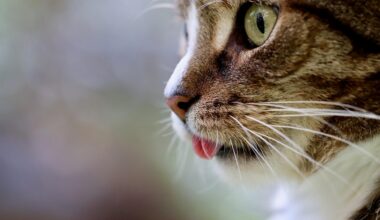How to Monitor Progress When Treating Cat Separation Anxiety
Separation anxiety in cats is a serious issue that can impact their overall mental and physical health. When we notice signs of this condition, our first priority should be to take a structured approach for managing it effectively. Treatment includes behavioral modification, medication, and environmental changes that can greatly assist in alleviating anxiety. To monitor progress, it is essential to establish a baseline by noting specific behaviors associated with separation anxiety. Things to observe include vocalization, litter box avoidance, and destructive behavior when the owner is away, as these are often prevalent symptoms. Keeping a diary of these instances can help track improvements over time. Consultation with a veterinarian is crucial in creating a tailored treatment plan for your feline friend. Regular check-ins, updates on behaviors, and observations will help the vet determine whether the treatment is effective or if adjustments are necessary. Using resources such as anxiety relief products or calming pheromones can also be beneficial in monitoring progress. By staying informed and proactive, you can enhance your cat’s quality of life while addressing their anxiety.
When implementing a treatment plan for separation anxiety, it is essential to stay consistent with your approach. Cats thrive on routine, and any changes can lead to increased stress and anxiety. As part of your monitoring process, establish a schedule that includes playtime, feeding times, and a set routine for when you leave and return home. This predictability can help your cat feel more secure. Keep an eye on progress indicators such as the reduction in crying or destructiveness, which signifies improvement in their comfort levels when you are not around. Some pet owners find that using a webcam provides insights into their cat’s behavior during their absence. You might notice if your cat is settling down after an initial period of distress, or if they are exhibiting less anxious behavior over time. It can also be important to have patience, as behavioral modifications can take time before visible improvements are seen. Celebrate small victories along the way. Every step towards reducing anxiety is valuable and worth recognizing as progress for both you and your feline companion. Tracking these developments will ultimately aid in achieving a serene environment.
Utilizing Tools for Monitoring
Utilizing various tools and resources can greatly enhance your ability to monitor your cat’s progress with separation anxiety. Consider using various apps or systems designed to monitor cat behaviors, allowing you to log instances of anxiety and note improvements over time. For example, there are apps that can help track daily behaviors, set reminders for medication, and provide information from experts about physical and emotional signs related to cat anxiety. Additionally, utilizing treat dispensing cameras helps analyze their behavior in real-time. These devices allow you to see how your cat reacts when alone and if the anxiety levels are decreasing. Subtle changes in behavior can indicate progress, such as less meowing or destructive tendencies. Remember to couple these observations with other methods such as charts or graphs, which might help visualize trends in behaviors. Assessing your cat’s adaptation to being alone using these tools not only increases awareness but can foster a deeper bond with your pet during the recovery process. The insights gained can also guide discussions with veterinarians or animal behaviorists to adjust the treatment plan if needed.
In addition to observing behaviors, engaging in interactive play can be an effective way to gauge your cat’s comfort level over time. When you dedicate quality time to bond with your feline, you create a sense of security that may diminish anxiety. Evaluating their enthusiasm during these play sessions can be a key indicator of their emotional state. If your cat appears more engaged and responsive, it suggests that anxiety may be decreasing. Conversely, if they remain unresponsive or fearful, it may indicate that further treatment adjustments are necessary. Maintaining a close relationship can foster trust, which is critical for alleviating separation anxiety. Mark any changes in behavior during playtime in your logs, focusing on their energy levels and willingness to engage. Playtime also offers an opportunity to introduce calming techniques, such as playing soothing music or using catnip to see if reactions improve. Keeping track of their interactions can help adjust play sessions to better suit their needs. Overall, observing playtime can provide valuable insights into your cat’s mental health as they cope with separation anxiety.
Communication with Professionals
Staying in communication with veterinarians and pet behaviorists will play a significant role in successfully monitoring your cat’s separation anxiety treatment. Professionals can offer you tailored advice based on the specific challenges your cat might be experiencing. Regular check-ins will allow you to share observations regarding your cat’s progress and express concerns or questions that arise throughout the treatment. Vets may recommend special assessments or tests to rule out other health issues that could be exacerbating anxiety symptoms. Tracking your cat’s behaviors and compiling all relevant data for your vet can help them make informed decisions regarding adjustments in medication or treatment plans. Be open to their suggestions; they might recommend therapy sessions or guided behavior training. Timely communication can lead to faster resolutions and ensure that your cat’s needs are being adequately addressed. It’s also helpful to discuss any changes you’ve made at home that are pertinent to their well-being. Overall, sustained dialogue with professionals fosters an effective treatment journey, paving the way for a balanced and secure environment for your cat.
Taking proactive steps to improve your cat’s environment is another crucial piece of the monitoring process. An enriched environment can play a significant role in reducing feelings of anxiety. Introduce various stimulating activities like scratching posts, climbing trees, and interactive toys that encourage mental engagement. These additions can distract your cat and provide positive experiences when left alone. Keep an eye on how your cat interacts with new elements in their surroundings; a rise in exploration and curiosity could signify improvement. Creating a safe space with their favorite items, such as blankets or toys, can also foster a comforting atmosphere. Recording how your cat utilizes this safe zone can assist in fine-tuning their environment over time. Entryways to small areas with enticing hideouts may create a sense of security, thus alleviating some anxiety. Complete ecological assessments can provide insights into how cats react emotionally to these changes. If enhancements lead to calmer behavior, flow charts can visualize ongoing success, ensuring adjustments are consistently monitored. Enrichment is vital to overall well-being, serving both as therapy and motivation for your furry friend.
Conclusion: Continuous Monitoring for Lasting Change
Monitoring your cat’s progress during their treatment for separation anxiety is a journey that requires diligence and love. The combination of structured observations, supportive environments, and professional guidance can significantly aid in overcoming anxiety. Reflect regularly on notes, behaviors, and improvements, as this insight will guide future actions and treatment decisions. Always celebrate small victories during your monitoring process, as they can lead to substantial positive changes over time. You may notice increases in your cat’s independence, reduced signs of stress, and a happier demeanor that can reflect in their overall health. Emphasize a holistic approach that encapsulates emotional, physical, and environmental elements to foster a therapeutic structure for your cat’s progress. Collaboration with professionals and constant reassessment will ensure that corrective measures are promptly taken if required, facilitating lasting change. Above all, nurture an environment of security, love, and patience on this journey. This continuous monitoring and commitment to wellness will shape the foundation for an emotionally healthy cat, reflecting positively on your relationship with them.
Education and learning about separation anxiety constitute an invaluable aspect of helping your cat through this challenge. Understanding the underlying causes, triggers, and effective treatments will equip you to provide the best care. Resources such as books, articles, or webinars focusing on feline behavior can deepen your knowledge and enable you to adjust your approach based on emerging information. These materials can offer insights into best practices for treatment and prevention strategies, enhancing your confidence as a caregiver. Sharing learned experiences with fellow cat owners also establishes a supportive community. Online forums or local pet groups may present a wealth of shared knowledge and anecdotal evidence that could serve you and your cat well. If your cat continues to exhibit anxiety despite observed progress, consider exploring alternative therapies or professional training tailored to separation anxiety. The exploration of techniques such as clicker training or feline acupuncture might supplement your original plan effectively. The road to recovery can be complex; the more you learn and adapt, the better you can meet your feline’s needs, ultimately fostering a bright future for your beloved pet.


